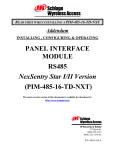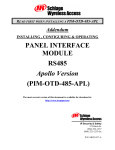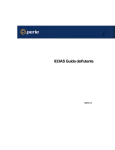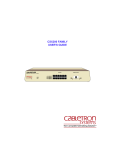Download Cabletron Systems BRIM-E6 Specifications
Transcript
WPIM-E1 LOCAL MANAGEMENT GUIDE NOTICE Cabletron Systems reserves the right to make changes in specifications and other information contained in this document without prior notice. The reader should in all cases consult Cabletron Systems to determine whether any such changes have been made. The hardware, firmware, or software described in this manual is subject to change without notice. IN NO EVENT SHALL CABLETRON SYSTEMS BE LIABLE FOR ANY INCIDENTAL, INDIRECT, SPECIAL, OR CONSEQUENTIAL DAMAGES WHATSOEVER (INCLUDING BUT NOT LIMITED TO LOST PROFITS) ARISING OUT OF OR RELATED TO THIS MANUAL OR THE INFORMATION CONTAINED IN IT, EVEN IF CABLETRON SYSTEMS HAS BEEN ADVISED OF, KNOWN, OR SHOULD HAVE KNOWN, THE POSSIBILITY OF SUCH DAMAGES. CAUTION: THE WPIM-E1 IS INTENDED TO BE INSTALLED IN TUV APPROVED EQUIPMENT BY A QUALIFIED SERVICE PERSON. CHECK THE EQUIPMENT OPERATION/INSTALLATION INSTRUCTIONS AND/OR EQUIPMENT MANUFACTURER TO VERIFY/CONFIRM YOUR EQUIPMENT IS SUITABLE FOR INSTALLED APPLICATION CARDS. CAUTION: ALWAYS DISCONNECT THE E1 BOARD (THE ONE WITH THE TELEPHONE PLUG/JACK) FROM THE TELEPHONE SYSTEM WHEN INSTALLING OR WHEN THE COVERS ARE REMOVED FROM THE HOST PRODUCT. Achtung: Das WPIM-E1 Modul darf nur von qualifiziertem Service Personal in TÜV-zugelassenen Geräten installiert werden. Vor dem Einbau muß in der Installationsanweisung und Funktionsbeschreibung des Gerätes überprüft werden ob das Modul kompatible ist und verwendet werden kann. Achtung: Die Verbindung zu dem E1-Modul (die Karte mit dem Telefonanschluß) muß bei Installationen getrennt werden. © Copyright 1996 by: Cabletron Systems, Inc., P.O. Box 5005, Rochester, NH 03866-5005 All Rights Reserved Printed in the United States of America Part Number: 9031484-02 February 1996 BRIM, EMM-E6, MicroMMAC and NBR-620 are registered trademarks and WPIM is a trademark of Cabletron Systems, Inc. All other product names mentioned in this manual may be trademarks or registered trademarks of their respective companies. Printed On Recycled Paper WPIM-E1 LOCAL MANAGEMENT GUIDE i NOTICE VCCI NOTICE This equipment is in the 1st Class Category (information equipment to be used in commercial and/or industrial areas) and conforms to the standards set by the Voluntary Control Council for Interference by Information Technology Equipment (VCCI) aimed at preventing radio interference in commercial and/or industrial areas. Consequently, when used in a residential area or in an adjacent area thereto, radio interference may be caused to radios and TV receivers, etc. Read the instructions for correct handling. CABLETRON SYSTEMS, INC. PROGRAM LICENSE AGREEMENT IMPORTANT: Before utilizing this product, carefully read this License Agreement. This document is an agreement between you, the end user, and Cabletron Systems, Inc. (“Cabletron”) that sets forth your rights and obligations with respect to the Cabletron software program (the “Program”) contained in this package. The Program may be contained in firmware, chips or other media. BY UTILIZING THE ENCLOSED PRODUCT, YOU ARE AGREEING TO BECOME BOUND BY THE TERMS OF THIS AGREEMENT, WHICH INCLUDES THE LICENSE AND THE LIMITATION OF WARRANTY AND DISCLAIMER OF LIABILITY. IF YOU DO NOT AGREE TO THE TERMS OF THIS AGREEMENT, PROMPTLY RETURN THE UNUSED PRODUCT TO THE PLACE OF PURCHASE FOR A FULL REFUND. CABLETRON SOFTWARE PROGRAM LICENSE 1. LICENSE. You have the right to use only the one (1) copy of the Program provided in this package subject to the terms and conditions of this License Agreement. You may not copy, reproduce or transmit any part of the Program except as permitted by the Copyright Act of the United States or as authorized in writing by Cabletron. 2. OTHER RESTRICTIONS. Program. You may not reverse engineer, decompile, or disassemble the 3. APPLICABLE LAW. This License Agreement shall be interpreted and governed under the laws and in the state and federal courts of New Hampshire. You accept the personal jurisdiction and venue of the New Hampshire courts. ii WPIM-E1 LOCAL MANAGEMENT GUIDE NOTICE EXCLUSION OF WARRANTY AND DISCLAIMER OF LIABILITY 1. EXCLUSION OF WARRANTY. Except as may be specifically provided by Cabletron in writing, Cabletron makes no warranty, expressed or implied, concerning the Program (including its documentation and media). CABLETRON DISCLAIMS ALL WARRANTIES, OTHER THAN THOSE SUPPLIED TO YOU BY CABLETRON IN WRITING, EITHER EXPRESS OR IMPLIED, INCLUDING BUT NOT LIMITED TO IMPLIED WARRANTIES OF MERCHANTABILITY AND FITNESS FOR A PARTICULAR PURPOSE, WITH RESPECT TO THE PROGRAM, THE ACCOMPANYING WRITTEN MATERIALS, AND ANY ACCOMPANYING HARDWARE. 2. NO LIABILITY FOR CONSEQUENTIAL DAMAGES. IN NO EVENT SHALL CABLETRON OR ITS SUPPLIERS BE LIABLE FOR ANY DAMAGES WHATSOEVER (INCLUDING, WITHOUT LIMITATION, DAMAGES FOR LOSS OF BUSINESS, PROFITS, BUSINESS INTERRUPTION, LOSS OF BUSINESS INFORMATION, SPECIAL, INCIDENTAL, CONSEQUENTIAL, OR RELIANCE DAMAGES, OR OTHER LOSS) ARISING OUT OF THE USE OR INABILITY TO USE THIS CABLETRON PRODUCT, EVEN IF CABLETRON HAS BEEN ADVISED OF THE POSSIBILITY OF SUCH DAMAGES. BECAUSE SOME STATES DO NOT ALLOW THE EXCLUSION OR LIMITATION OF LIABILITY FOR CONSEQUENTIAL OR INCIDENTAL DAMAGES, OR ON THE DURATION OR LIMITATION OF IMPLIED WARRANTEES IN SOME INSTANCES THE ABOVE LIMITATIONS AND EXCLUSIONS MAY NOT APPLY TO YOU. UNITED STATES GOVERNMENT RESTRICTED RIGHTS The enclosed product (a) was developed solely at private expense; (b) contains “restricted computer software” submitted with restricted rights in accordance with Section 52227-19 (a) through (d) of the Commercial Computer Software - Restricted Rights Clause and its successors, and (c) in all respects is proprietary data belonging to Cabletron and/or its suppliers. For Department of Defense units, the product is licensed with “Restricted Rights” as defined in the DoD Supplement to the Federal Acquisition Regulations, Section 52.227-7013 (c) (1) (ii) and its successors, and use, duplication, disclosure by the Government is subject to restrictions as set forth in subparagraph (c) (1) (ii) of the Rights in Technical Data and Computer Software clause at 252.227-7013. Cabletron Systems, Inc., 35 Industrial Way, Rochester, New Hampshire 03867. WPIM-E1 LOCAL MANAGEMENT GUIDE iii TABLE OF CONTENTS CHAPTER 1 1.1 1.2 1.3 1.4 1.5 USING THIS MANUAL ................................................................ 1-1 GETTING HELP .......................................................................... 1-2 WPIM-E1 FEATURES ................................................................. 1-2 WPIM-E1 SPECIFICATIONS ...................................................... 1-3 RELATED MANUALS.................................................................. 1-4 CHAPTER 2 2.1 2.2 2.3 2.4 2.5 2.6 INTRODUCTION LOCAL MANAGEMENT THE WAN PHYSICAL CONFIGURATION SCREEN .................. 2-2 2.1.1 WAN Physical Configuration Screen Fields ................... 2-2 2.1.2 WPIM-E1 Configuration Fields ....................................... 2-3 2.1.3 The WPIM Timeslot Configuration Table........................ 2-5 THE WAN INTERFACE CONFIGURATION SCREEN ............... 2-7 2.2.1 WAN Interface Configuration Screen Fields................... 2-8 FULL E-1 CONFIGURATION USING PPP ............................... 2-10 2.3.1 WPIM-E1 Physical Configuration ................................. 2-11 2.3.2 WPIM-E1 Interface Configuration................................. 2-12 FRACTIONAL E-1 CONFIGURATION USING PPP ................. 2-14 2.4.1 WPIM-E1 Physical Configuration ................................. 2-15 2.4.2 WPIM-E1 Interface Configuration................................. 2-17 FRAME RELAY CONFIGURATION .......................................... 2-18 2.5.1 WPIM-E1 Physical Configuration ................................. 2-19 2.5.2 WPIM-E1 Interface Configuration................................. 2-21 LEX CONFIGURATION............................................................. 2-22 2.6.1 WPIM-E1 Physical Configuration ................................. 2-22 2.6.2 WPIM-E1 Interface Configuration................................. 2-24 APPENDIX A WAN INTERFACE CABLE SPECIFICATIONS APPENDIX B WAN TERMS AND ACRONYMS WPIM-E1 LOCAL MANAGEMENT GUIDE v CHAPTER 1 INTRODUCTION Welcome to the Cabletron Systems WPIM-E1 Local Management Guide. This manual explains how to use Local Management to control and manage the Cabletron Systems WPIM-E1. Appendix A of this guide provides connector and pinout information for the WPIM-E1. The WPIM-E1 resides in and provides connectivity/functionality to Cabletron Systems Wide Area Network (WAN) modules such as the BRIM-W6. Before using this manual you must: • Install the WPIM-E1 in a Wide Area Network module. Refer to the appropriate manual (i.e., the BRIM-W6 User’s Guide) for installation and troubleshooting procedures. • Setup and access Local Management. Refer to the appropriate MIM, standalone hub, or module User’s Guide for instructions on setting up and accessing Local Management. 1.1 USING THIS MANUAL Read through this manual completely to familiarize yourself with its content and to gain an understanding of the features and capabilities of the WPIM-E1. You should have a general working knowledge of the following data communications networks and their physical layer components before using the WPIM-E1. • • • WAN Ethernet and IEEE 802.3 Token Ring and 802.5 WPIM-E1 LOCAL MANAGEMENT GUIDE 1-1 CHAPTER 1: INTRODUCTION The following list briefly explains each chapter of the WPIM-E1 manual: Chapter 1, Introduction, outlines the contents of this manual, describes WPIM-E1 features, lists specifications, and concludes with a list of related manuals. Chapter 2, Local Management, describes how to use Local Management to setup the WPIM-E1. Appendix A, WAN Interface Cable Specifications, provides Cabletron part numbers and connector information for the interface cables used with the WPIM-E1. Appendix B, WAN Terms and Acronyms, is a brief glossary of the terms used in this book. 1.2 GETTING HELP If you need additional support related to the WPIM-E1, or if you have any questions, comments, or suggestions concerning this manual, contact Cabletron Systems Technical Support: By phone ..........................(603) 332-9400 Monday-Friday; 8am - 8pm Eastern Time By CompuServe ...............GO CTRON from any ! prompt By Internet mail [email protected] By FTP .............................ctron.com (134.141.197.25) Login: anonymous, Password: your email address 1.3 WPIM-E1 FEATURES The WPIM-E1 extends the functionality of your Wide Area Network module to allow remote connectivity using WAN services such as E-1 or Fractional E-1. The WPIM-E1 provides an E-1 interface that includes a built-in Channel Service Unit/Digital Service Unit (CSU/DSU) for direct connection to an E-1 line. This WPIM supports both Full E-1 or Fractional E-1 using 56 or 64 Kbps timeslots. 1-2 WPIM-E1 LOCAL MANAGEMENT WPIM-E1 SPECIFICATIONS WAN Protocols As of this printing, the module in which the WPIM-E1 is installed supports the following WAN protocols (refer to the Release Notes included with the host MIM or standalone hub for a list of current protocols): • • • • Point to Point Protocol (LCP ) as defined by RFC 1661 Point to Point Protocol (BNCP) as defined by RFC 1638 Point to Point Protocol LAN Extender (PPP/LEX) Frame Relay as defined by RFC 1490 MIB Support Refer to the Release Notes included with the host MIM or standalone hub for a list of all MIBs supported by the WPIM-E1. For information about how to extract and compile individual MIBs, contact Cabletron Systems Technical Support (see Getting Help). 1.4 WPIM-E1 SPECIFICATIONS This section describes the environmental specifications and safety/approval requirements for the WPIM-E1. Cabletron Systems reserves the right to change these specifications at any time without notice. Environmental Requirements Operating Temperature: +5° to +40°C (41° to 104°F) Non-operating Temperature: -30° to +90°C (-22° to 194°F) Operating Humidity: 5% to 95% (non-condensing) Safety This unit meets the safety requirements of EN60950. EMI This unit meets the EMI requirements of EN55022 Class A and VCCI Class I. WPIM-E1 LOCAL MANAGEMENT GUIDE 1-3 CHAPTER 1: INTRODUCTION EMC This unit meets the EMC requirements of EN50082-1 including IEC 801-2 (ESD), IEC 801-3 (Radiated Susceptibility), and IEC 801-4 (EFT/B). WARNING 1.5 It is the responsibility of the person who sells the system to which the WPIM-E1 will be a part to ensure that the total system meets allowed limits of conducted and radiated emissions. RELATED MANUALS Refer to the manual included with the host Wide Area Network module (e.g., the BRIM-W6 User’s Guide) to supplement the procedures and other technical data provided in this manual. Refer to the MIM, standalone hub or module User’s Guides and/or Local Management Guides for Local Management setup information. This manual references procedures in these manuals, where appropriate, but does not repeat them. 1-4 WPIM-E1 LOCAL MANAGEMENT CHAPTER 2 LOCAL MANAGEMENT This Chapter explains how to configure the WPIM-E1 through Local Management. The WAN Physical Configuration screen and the WAN Interface Configuration screen appear as Local Management menu selections after you install the WPIM-E1 into a WAN module such as the BRIM-W6 and then install the BRIM into a MIM or standalone hub. Refer to the MIM or standalone hub User’s Guide for instructions about how to setup and access Local Management. Sections of this chapter include: • The WAN Physical Configuration screen 2.1 • The WAN Interface Configuration screen 2.2 • Full T-1 Configuration Using PPP 2.3 • Fractional T-1 Configuration Using PPP 2.4 • Frame Relay Configuration 2.5 • LEX Configuration 2.6 Read Sections 2.1 and 2.2 to gain an understanding of the WPIM-E1 Local Management screens. Sections 2.3 through 2.6 provide examples for setting up the WPIM-E1 for full or fractional E-1 in a PPP environment, or for configuring the WPIM-E1 for LEX or Frame Relay. TIP Navigate through the WPIM Local Management Screens by using the following keyboard commands: SPACEBAR to toggle between selections in a field. ENTER (RETURN) to implement a selection. Arrow keys to move up, down or sideways within the screen. WPIM-E1 LOCAL MANAGEMENT GUIDE 2-1 CHAPTER 2: LOCAL MANAGEMENT 2.1 THE WAN PHYSICAL CONFIGURATION SCREEN To access the WAN Physical Configuration screen from the Feature Selection screen, use the arrow keys to highlight the WAN Configuration option, then press ENTER. The screen shown in Figure 2-1 appears. <host name> Local Management Flash Image Version: xx.xx.xx WAN PHYSICAL CONFIGURATION WPIM 1 WPIM 2 Type: E1 BRIM #: 1 Mode: [Primary] Active: Yes Interfaces: 002-033 Type: SY BRIM #: 1 Mode: [Secondary] Active: No Interfaces: 034 WPIM 1 Timeslot Configuration WPIM 1 Line Configuration E1 Timeslot View: E1 Line Coding: E1 Frame Type: E1 TX Clock Source: E1 Network Loopback: [Active] [HDB3] [E1-CRC] [Loop-Timing] [None] 01-08 N/A 000 000 000 000 000 000 000 09-16 000 000 000 000 000 000 000 000 17-24 000 000 000 000 000 000 000 000 25-32 000 000 000 000 000 000 000 000 SAVE [WPIM 1] WAN INT CONFIG RETURN 1484_01 Figure 2-1. WAN Physical Configuration Screen 2.1.1 WAN Physical Configuration Screen Fields The following sections describe WAN Physical Configuration screen fields and instructions for setting them. The WAN Physical Configuration screen lets you configure the WPIM or “Physical Interface.” Cabletron offers a variety of WPIMs. The following Physical Configuration screen examples show the WPIM-E1 and the WPIM-SY. Select the WPIM you wish to configure by using the arrow keys to highlight the WPIM command field at the bottom of the screen. Press the SPACEBAR to select the appropriate WPIM, then press ENTER. The WAN Configuration screen automatically displays unique configuration fields for each WPIM as shown in Figure 2-1. 2-2 WPIM-E1 LOCAL MANAGEMENT GUIDE THE WAN PHYSICAL CONFIGURATION SCREEN The WAN Physical Configuration screen displays the following information for each WPIM: WPIM 1-4 Displays configuration information for as many as four WPIMs. Each BRIM-W6 supports two WPIMs. Some of Cabletron’s products (e.g., the NBR-620 or the EMM-E6) will support two BRIM-W6 modules providing connectivity for as many as four WPIMs. Only one WPIM per BRIM-W6 can be active. NOTE Type Displays the WPIM type. BRIM # Displays the BRIM slot in which the WPIM resides. Mode Displays the WPIM mode. Toggles between Primary and Secondary. In a device such as the BRIM-W6 where two WPIMs are utilized but only one can be active at a given time, the second WPIM installed or recognized defaults to Secondary. Active Displays the status of the WPIM, Yes and No. Interfaces Displays the interfaces available to each WPIM. 2.1.2 WPIM-E1 Configuration Fields The configuration fields displayed on the Physical Configuration screen shown in Figure 2-1 vary depending on the type of WPIM. The examples in this Local Management Guide cover the WPIM-E1. Each Cabletron WPIM has a Local Management Guide that provides specific configuration guidelines and examples. WPIM-E1 LOCAL MANAGEMENT GUIDE 2-3 CHAPTER 2: LOCAL MANAGEMENT NOTE The service provider determines the settings for the following fields. Consult the service provider for the correct settings. E1 Timeslot View Displays the status of the Timeslot Configuration Table. The selections for this field toggle between Active and New. The Active setting displays current Timeslot Configuration table settings. The default setting is Active. The New setting allows you to change Timeslot Configuration table settings. The default setting for the Timeslot Configuration table is all Timeslots not assigned (000). E1 Line Coding Displays the line coding for the physical E-1 line. The selections toggle between HDB3 and AMI. The default setting for this field is HDB3. E1 Frame Type Displays the E-1 Frame type. The selections toggle between E1 and E1-CRC. The default setting for this field is E1-CRC. E1 Tx Clock Source Displays the E-1 Transmit Clock Source. The selections for this field toggle between Loop-Timing (Extracted Line Data) and Local-Timing (Internal Clock). The default setting for this field is Loop-Timing. E1 Network Loopback Network Loopback is a testing procedure that segments the line and allows the user to isolate faults. The selections for this field toggle between None and Line-Loop. In Line-Loop all 32 channels are looped back to the E-1 line.The WPIM-E1 must be in Loop-Timing mode to use this option. The default setting is None. 2-4 WPIM-E1 LOCAL MANAGEMENT GUIDE THE WAN PHYSICAL CONFIGURATION SCREEN 2.1.3 The WPIM Timeslot Configuration Table The WPIM Timeslot Configuration Table allows the user to configure the way in which the Cabletron WAN module uses the E-1 line. The configuration table consists of 32 Timeslots. Only 31 of the Timeslots are available for use because the first Timeslot is used by the device to transmit framing data. N/A (Not Available) always appears in Timeslot #1. You must assign each of the remaining 31 Timeslots an Interface number (for example, 002 for an active Interface number or 000 if the Timeslot is not used). When you lease an entire E-1 line, you can use all 31 Timeslots (the full E-1 bandwidth). If you lease only a fraction of the E-1, the service provider tells you which Timeslots to use. The WPIM-E1 always uses the first Timeslot (Timeslot #1) to transmit framing data. A full E-1 line with 32 Timeslots has 31 customer-usable Timeslots. NOTE You can utilize Timeslots any way you choose. The WPIM-E1 supports Time Division Multiplexing (TDM) allowing channelization of circuits (Timeslots) within the public network. For example, if your BRIM-W6 has access to a full E-1 (31 customer-usable Timeslots), and you want to communicate with two other sites, your configuration might look like Figure 2-2. SITE #2 23 Timeslots SITE #1 Telco Cloud 32 Timeslots (31 available to customer) SITE #3 8 Timeslots 1484_02 Figure 2-2. Sample Timeslot Configuration WPIM-E1 LOCAL MANAGEMENT GUIDE 2-5 CHAPTER 2: LOCAL MANAGEMENT Figure 2-3 shows a sample configuration for three sites. Of the 32 Timeslots, Site #1 uses the first Timeslot for transmitting framing data, 23 Timeslots to communicate with Site #2 and the remaining 8 Timeslots to communicate with Site #3. This configuration varies tremendously depending on how the service provider maps out the E-1 Timeslots. Your service provider will tell you which Timeslots are active and where they go in the cloud. 01-08 N/A 005 005 005 005 005 005 005 09-16 005 005 005 005 005 005 005 005 17-24 005 005 005 005 005 005 005 005 25-32 006 006 006 006 006 006 006 006 SITE #1 01-08 N/A 005 005 005 005 005 005 005 09-16 005 005 005 005 005 005 005 005 17-24 005 005 005 005 005 005 005 005 25-32 000 000 000 000 000 000 000 000 SITE #2 01-08 N/A 006 006 006 006 006 006 006 09-16 006 000 000 000 000 000 000 000 17-24 000 000 000 000 000 000 000 000 25-32 000 000 000 000 000 000 000 000 SITE #3 1484_03 Figure 2-3. Sample Configuration Site #1 is using the full E-1, so all the Timeslots must have an Interface assignment. Site #2 and Site #3 only use a fraction of the E-1, but the total quantity of Timeslots must match those of Site #1. Unused Timeslots receive an Interface number of 000. NOTE 2-6 The Interface numbers of Site #1, Site #2 and Site #3 do not have to match. Only the quantity of Timeslots must match (the service provider assigns the Timeslots). WPIM-E1 LOCAL MANAGEMENT GUIDE THE WAN INTERFACE CONFIGURATION SCREEN 2.2 THE WAN INTERFACE CONFIGURATION SCREEN This section describes the features of the WAN Interface Configuration screen. Access the screen by using the arrow keys to highlight the WAN Int Config option at the bottom of the Physical Configuration screen, then press ENTER. The WAN Interface Configuration screen shown in Figure 2-4 appears. <host name> Local Management Flash Image Version: xx.xx.xx WAN INTERFACE CONFIGURATION Interface Number: Data Compression: Max Xmit Unit: Line Coding: Active Protocol: SAVE [002] [NO] 0 [NONE] [NONE] PT# IF# LID STATE PT# IF# LID STATE 001 001 Enet 002 003 004 005 006 007 008 009 010 011 012 013 014 015 016 017 018 019 020 021 022 023 024 025 026 027 028 029 030 031 032 UP RETURN 1484_04 Figure 2-4. WAN Interface Configuration Screen WPIM-E1 LOCAL MANAGEMENT GUIDE 2-7 CHAPTER 2: LOCAL MANAGEMENT 2.2.1 WAN Interface Configuration Screen Fields This section describe the WAN Interface Configuration screen fields. Interface Number Displays the active Interface Numbers. Use this field to configure the Interface Numbers you assigned to the Timeslots on the WAN Physical Configuration screen. Data Compression Displays the status of Data Compression. This field displays YES or NO. The default setting is NO. Max Xmit Unit User-configured field that displays the maximum packet size that can be transmitted on the selected Interface. The default values are 8191 for PPP and 4095 for Frame Relay. Line Coding Displays the Line Coding for Timeslots associated with this interface. This field displays JBZS, INV-HDLC, or None. The default setting is None. Active Protocol Displays the active OSI Layer protocol. This field displays None, FR (Frame Relay), or PPP (Point-to-Point). The default setting is None. If you select PPP, the following field appears: PPP Type: This field displays BNCP or LEX. If you select FR, the following field appears: FR LMP: 2-8 This field displays NO LMI, Q.933-A or T1.617-D. This field is normally set to Q.933-A (the European standard). The NO LMI setting is for specialized applications in which no Frame Relay Link Management is available or required. WPIM-E1 LOCAL MANAGEMENT GUIDE THE WAN INTERFACE CONFIGURATION SCREEN If NO LMI is selected, the following fields are displayed: DLCI Address: This field can be set to values from 0-1023. The values 0-15 and 1008-1022 are reserved DLCI addresses. Circuit State: Toggles between Active, Inactive and Invalid. PT# Displays the application ports (bridge ports) available from the host platform to the WAN. If the active protocol is PPP, Local Management assigns only one application port per interface number (IF#). If the active protocol is Frame Relay, Local Management assigns the available WAN bridge ports from the host platform, one per DLCI. You can assign WAN application ports to the 31 interfaces for the PPP configuration that suits your needs. In a Frame Relay configuration, you can assign all WAN application ports to one interface. In this example, the remaining 30 interfaces would not have WAN application ports available. The quantity of application ports for a Frame Relay network is determined by the quantity of DLCIs (Data Link Connection Identifiers) assigned to that Interface. This is determined either manually or by the LMP (Link Management Protocol). IF# Displays the Interface that is associated with the application port. LID Displays the Link Identifier. If the active protocol is Frame Relay, the Data Link Connection Identifier is displayed. If the active protocol for this interface is PPP, then PPP appears in this field. STATE Displays the status of the application port. If the active protocol is Frame Relay, this field displays the status as Active, Inactive, or Disabled (for No LMI). If the active protocol is PPP, this field displays UP (for active) or DOWN (for inactive). WPIM-E1 LOCAL MANAGEMENT GUIDE 2-9 CHAPTER 2: LOCAL MANAGEMENT 2.3 FULL E-1 CONFIGURATION USING PPP This section provides step-by-step instructions for configuring the WPIM-E1 to use a full E-1 circuit in a PPP environment. This simplified example assumes the setup shown in figure 2-5 using a MicroMMAC hub with a BRIM-W6 containing a WPIM-E1 at Site #1. Configurations may vary depending on the hub. SITE 1 Telco Cloud 32 Timeslots (31 customer-usable) SITE 2 32 Timeslots (31 customer-usable) 1484_05 Figure 2-5. Full E-1 Configuration The line configuration information shown in Table 2-1 must be supplied by the service provider. Table 2-1. Telco Configuration Information Configuration Information Required By User Configuration Information Supplied By Service Provider Line Coding HDB3 or AMI Frame Type E1 or E1-CRC Clock Source Loop Timing or Local Timing 2-10 WPIM-E1 LOCAL MANAGEMENT GUIDE FULL E-1 CONFIGURATION USING PPP 2.3.1 WPIM-E1 Physical Configuration Begin the WPIM-E1 configuration by accessing the WAN Physical Configuration screen through Local Management (Figure 2-1). Access the WAN Physical Configuration screen from the Feature Selection screen that first appears when you enter Local Management. Use the arrow keys to highlight the WAN Configuration option, then press ENTER. The screen shown in Figure 2-1 appears. Proceed with the following steps: 1. Use the arrow keys to highlight the [WPIM] field at the bottom of the screen. Press the SPACEBAR to select the WPIM being configured, then press ENTER. 2. Use the arrow keys to highlight Timeslot View. Press the SPACEBAR to select New, then press ENTER. The cursor moves to Timeslot #2 of the Timeslot Configuration Table. 3. Insert an interface number (see NOTE below) into every Timeslot. Type the number, press ENTER, then use the arrow keys to highlight the next Timeslot field. Exit this field by using the arrow keys. The cursor automatically moves to the E1 Line Coding field. NOTES The value assigned to the Timeslots is the interface being used for WAN communication. The available interface range is displayed on the WAN Physical Configuration screen (see Figure 2-1). You may insert any of the available interface numbers into the Timeslots. In the example shown in Figure 2-1, the interface range for the MicroMMAC with a WPIM-E1 in slot one of the BRIM-W6 is 2-33. Although any of these values may be used, Cabletron Systems recommends using the first available interface number (in this example interface #2). The following three steps are based on information supplied by the service provider. Consult the service provider for the correct settings. WPIM-E1 LOCAL MANAGEMENT GUIDE 2-11 CHAPTER 2: LOCAL MANAGEMENT 4. Use the arrow keys to highlight E1 Line Coding. Press the SPACEBAR to select HDB3 or AMI, then press ENTER. 5. Use the arrow keys to highlight E1 Frame Type. Press the SPACEBAR to select E1 or E1-CRC, then press ENTER. 6. Use the arrow keys to highlight E1 Tx Clock Source. Press the SPACEBAR to select Local (no clock source provided by telephone company) or Loop (clock source provided by telephone company), then press ENTER. ! If you are using a Local clock source, set only one end of the circuit for Local, the other end must be set for Loop. CAUTION 7. Use the arrow keys to highlight E1 Network Loopback. Press the SPACEBAR to select None, then press ENTER. 8. Use the arrow keys to highlight the SAVE command, then press ENTER. The message “Save Done!” appears and Local Management saves the changes to memory. 9. Access the WAN Interface Configuration screen by using the arrow keys to highlight the WAN Int Config option, then press ENTER. 2.3.2 WPIM-E1 Interface Configuration This screen is accessed through the WAN Physical Configuration screen. Refer to Figure 2-4 and proceed with the following steps to configure the WAN Interface through Local Management. 1. Set the WAN connection Interface Number by typing the same number into the Interface Number field that was input into the Timeslots in the WAN Physical Configuration screen, then press ENTER (see NOTE on page 2-11). 2. Unless the user sets the Max Xmit Unit, the WPIM-E1 automatically sets the Max Xmit Unit to 8191 (default) after the active protocol (PPP) is selected. 2-12 WPIM-E1 LOCAL MANAGEMENT GUIDE FULL E-1 CONFIGURATION USING PPP 3. If the E1 Line Coding is HDB3 on the previous screen: a. Use the arrow keys to highlight Line Coding. Press the SPACEBAR to select None, then press ENTER. b. Use the arrow keys to highlight Active Protocol. Press the SPACEBAR to select PPP, then press ENTER. c. Use the arrow keys to highlight PPP Type. Press the SPACEBAR to select BNCP, then press ENTER. 4. If the E1 Line Coding is AMI on the previous screen: a. Use the arrow keys to highlight Line Coding. Press the SPACEBAR to select INV-HDLC, then press ENTER. b. Use the arrow keys to highlight Active Protocol. Press the SPACEBAR to select PPP, then press ENTER. c. Use the arrow keys to highlight PPP Type. Press the SPACEBAR to select BNCP, then press ENTER. 5. Use the arrow keys to highlight the SAVE command, then press ENTER. The message “Save Done!” appears and Local Management saves the changes to memory. NOTE Upon saving this screen, the interface just configured is assigned to an application port (PT#) in the table on the right hand side of the screen. The WAN configuration is complete. It takes up to 60 seconds for the WAN Interface to come out of standby and for communications to begin. WPIM-E1 LOCAL MANAGEMENT GUIDE 2-13 CHAPTER 2: LOCAL MANAGEMENT 2.4 FRACTIONAL E-1 CONFIGURATION USING PPP This section provides step-by-step instructions for configuring the WPIM-E1 to use a fractional E-1 circuit in a PPP environment. This example assumes the setup shown in figure 2-6 using two MicroMMAC hubs each with a BRIM-W6 containing a WPIM-E1. Configurations may vary depending on the hub. In a fractional E-1 setup, only a portion of the 32 Timeslots or DS-0’s are used. NOTE The terms DS-0 (Digital Signal, level 0) and Timeslot are used synonymously in this guide to represent a standard 64,000 bit/second channel. SITE #2 with BRIM-W6 SITE #1 with BRIM-W6 16 Timeslots Telco Cloud 16 Timeslots 1484_06 Figure 2-6. Fractional E-1 Configuration 2-14 WPIM-E1 LOCAL MANAGEMENT GUIDE FRACTIONAL E-1 CONFIGURATION USING PPP The line configuration information shown in Table 2-2 must be supplied by the service provider. Table 2-2. Telco Configuration Information Configuration Information Required By User Configuration Information Supplied By Service Provider Line Coding HDB3 or AMI Frame Type E1 or E1-CRC Clock Source Loop Timing or Local Timing DS-0’s (Timeslots) Timeslots being used for each end of the circuit 2.4.1 WPIM-E1 Physical Configuration Begin the WPIM-E1 configuration by accessing the WAN Physical Configuration screen through Local Management (Figure 2-1). Proceed with the following steps: 1. Use the arrow keys to highlight the [WPIM] field at the bottom of the screen. Press the SPACEBAR to toggle the field to the WPIM being configured, then press ENTER. 2. Use the arrow keys to highlight Timeslot View. Press the SPACEBAR to select New, then press ENTER. The cursor moves to Timeslot #2 of the Timeslot Configuration Table. 3. Insert an interface number (see NOTE below) into every Timeslot being used (in the example shown in Figure 2-6, 16 Timeslots are being used, the rest have zeros in them). Type the number, press ENTER, then use the arrow keys to highlight the next Timeslot field. Exit this field by using the arrow keys.The cursor automatically moves to the E1 Line Coding field. WPIM-E1 LOCAL MANAGEMENT GUIDE 2-15 CHAPTER 2: LOCAL MANAGEMENT NOTES The value assigned to the Timeslots is the interface being used for WAN communication. The available interface range is displayed on the WAN Physical Configuration screen (see Figure 2-1). You may insert any of the available interface numbers into the Timeslots. In the example shown in Figure 2-1, the interface range for the MicroMMAC with a WPIM-E1 in slot one of the BRIM-W6 is 2-33. Although any of these values may be used, Cabletron Systems recommends using the first available interface number (in this example interface #2). The following three steps are based on information supplied by the service provider. Consult the service provider for the correct settings. 4. Use the arrow keys to highlight E1 Line Coding. Press the SPACEBAR to select HDB3 or AMI, then press ENTER. 5. Use the arrow keys to highlight E1 Frame Type. Press the SPACEBAR to select E1 or E1-CRC, then press ENTER. 6. Use the arrow keys to highlight E1 Tx Clock Source. Press the SPACEBAR to select Local (no clock source provided by telephone company) or Loop (clock source provided by telephone company), then press ENTER. ! If you are using a Local clock source, set only one end of the circuit for Local, the other end must be set for Loop. CAUTION 7. Use the arrow keys to highlight the SAVE command, then press ENTER. The message “Save Done!” appears and Local Management saves the changes to memory. 8. Access the WAN Interface Configuration screen by using the arrow keys to highlight the WAN Int Config option and then press ENTER. 2-16 WPIM-E1 LOCAL MANAGEMENT GUIDE FRACTIONAL E-1 CONFIGURATION USING PPP 2.4.2 WPIM-E1 Interface Configuration This screen is accessed through the WAN Physical Configuration screen. Proceed with the following steps to configure the WAN Interface through Local Management. 1. Set the WAN connection Interface Number by typing the same number into the Interface Number field that was input into the Timeslots in the WAN Physical Configuration screen, then press ENTER. (see NOTE on page 2-16). 2. Unless the user sets the Max Xmit Unit, the WPIM-E1 automatically sets the Max Xmit Unit to 8191 (default) after the active protocol (PPP) is selected. 3. If the E1 Line Coding is HDB3 on the previous screen: a. Use the arrow keys to highlight Line Coding. Press the SPACEBAR to select None, then press ENTER. b. Use the arrow keys to highlight Active Protocol. Press the SPACEBAR to select PPP, then press ENTER. c. Use the arrow keys to highlight PPP Type. Press the SPACEBAR to select BNCP, then press ENTER. 4. If the E1 Line Coding is AMI on the previous screen: a. Use the arrow keys to highlight Line Coding. Press the SPACEBAR to select INV-HDLC, then press ENTER. b. Use the arrow keys to highlight Active Protocol. Press the SPACEBAR to select PPP, then press ENTER. c. Use the arrow keys to highlight PPP Type. Press the SPACEBAR to select BNCP, then press ENTER. 5. Use the arrow keys to highlight the SAVE command, then press ENTER. The message “Save Done!” appears and Local Management saves the changes to memory. WPIM-E1 LOCAL MANAGEMENT GUIDE 2-17 CHAPTER 2: LOCAL MANAGEMENT NOTE Upon saving this screen, the interface just configured is assigned to an application port (PT#) in the table on the right hand side of the screen. The WAN configuration is complete. It takes up to 60 seconds for the WAN Interface to come out of standby and for communications to begin. 2.5 FRAME RELAY CONFIGURATION This section provides step-by-step instructions for configuring the WPIM-E1 to use an E-1 circuit in a Frame Relay environment. This example assumes the setup shown in figure 2-7 using two MicroMMAC hubs each with a BRIM-W6 containing a WPIM-E1. Configurations may vary depending on the hub. SITE 1 Telco Cloud 32 Timeslots (31 customer-usable) SITE 2 32 Timeslots (31 customer-usable) 1484_05 Figure 2-7. Frame Relay Configuration The following information must be supplied to the service provider. • 2-18 LMP type: Q.933-A WPIM-E1 LOCAL MANAGEMENT GUIDE FRAME RELAY CONFIGURATION The line configuration information shown in Table 2-3 must be supplied by the service provider. Table 2-3. Telco Configuration Information Configuration Information Required By Customer Information Supplied By Service Provider Line Coding HDB3 or AMI Frame Type E1 or E1-CRC Clock Source Loop Timing or Local Timing DSO’s (Timeslots) Timeslots being used for each end of the circuit 2.5.1 WPIM-E1 Physical Configuration Begin the WPIM-E1 configuration by accessing the WAN Physical Configuration screen through Local Management (Figure 2-1). Proceed with the following steps: 1. Use the arrow keys to highlight the [WPIM] field at the bottom of the screen. Press the SPACEBAR to select the WPIM being configured, then press ENTER. 2. Use the arrow keys to highlight Timeslot View. Press the SPACEBAR to select New, then press ENTER. The cursor moves to Timeslot #2 of the Timeslot Configuration Table. 3. Insert an interface number (see NOTE below) into every Timeslot being used. Type the number, press ENTER, then use the arrow keys to highlight the next Timeslot field. Exit this field by using the arrow keys. The cursor automatically moves to the E1 Line Coding field. WPIM-E1 LOCAL MANAGEMENT GUIDE 2-19 CHAPTER 2: LOCAL MANAGEMENT NOTES The value assigned to the Timeslots is the interface being used for WAN communication. The available interface range is displayed on the WAN Physical Configuration screen (see Figure 2-1). You may insert any of the available interface numbers into the Timeslots. In the example shown in Figure 2-1, the interface range for the MicroMMAC with a WPIM-E1 in slot one of the BRIM-W6 is 2-33. Although any of these values may be used, Cabletron Systems recommends using the first available interface number (in this example interface #2). The following three steps are based on information supplied by the service provider. Consult the service provider for the correct settings. 4. Use the arrow keys to highlight E1 Line Coding. Press the SPACEBAR to select HDB3 or AMI, then press ENTER. 5. Use the arrow keys to highlight E1 Frame Type. Press the SPACEBAR to select E1 or E1-CRC, then press ENTER. 6. Use the arrow keys to highlight E1 Tx Clock Source. Press the SPACEBAR to select Local (no clock source provided by telephone company) or Loop (clock source provided by telephone company), then press ENTER. ! If you are using a Local clock source, set only one end of the circuit for Local, the other end must be set for Loop. CAUTION 7. Use the arrow keys to highlight the SAVE command, then press ENTER. The message “Save Done!” appears and Local Management saves the changes to memory. 8. Access the WAN Interface Configuration screen by using the arrow keys to highlight the WAN Int Config option and then press ENTER. 2-20 WPIM-E1 LOCAL MANAGEMENT GUIDE FRAME RELAY CONFIGURATION 2.5.2 WPIM-E1 Interface Configuration This screen is accessed through the WAN Physical Configuration screen. Proceed with the following steps to configure the WAN Interface through Local Management. 1. Set the WAN connection Interface Number by typing the same number into the Interface Number field that was input into the Timeslots in the WAN Physical Configuration screen, then press ENTER. (see NOTE on page 2-20). 2. Use the arrow keys to highlight Line Coding. Press the SPACEBAR to select None, then press ENTER. 3. Use the arrow keys to highlight Active Protocol. Press the SPACEBAR to select FR, then press ENTER. 4. Use the arrow keys to highlight FR LMP. Press the SPACEBAR to select Q.933-A, then press ENTER. 5. Use the arrow keys to highlight the SAVE command, then press ENTER. The message “Save Done!” appears and Local Management saves the changes to memory. NOTE Upon saving this screen, the interface just configured is assigned to an application port (PT#) in the table on the right hand side of the screen once the device starts communicating with the service provider’s switch. The WAN configuration is complete. Communications between the WPIM-E1 and the service provider’s switch takes approximately 1-2 minutes to begin. A status of Inactive appears until both ends of the PVC (Permanent Virtual Circuit) are configured. Once both end devices have negotiated link management with the switches, the status field reads Active. WPIM-E1 LOCAL MANAGEMENT GUIDE 2-21 CHAPTER 2: LOCAL MANAGEMENT 2.6 LEX CONFIGURATION This section provides step-by-step instructions for configuring the WPIM-E1 to operate in a LEX environment. LEX (LAN Extender) is a Cisco Systems protocol that allows a core router to communicate to a remote site using PPP. The line configuration information shown in Table 2-4 must be supplied by the service provider. Table 2-4. Telco Configuration Information Configuration Information Required by User Configuration Information Supplied by Service Provider Line Coding HDB3 or AMI Frame Type E1 or E1-CRC Clock Source Loop Timing or Local Timing 2.6.1 WPIM-E1 Physical Configuration Begin the WPIM-E1 configuration by accessing the WAN Configuration screen through Local Management (Figure 2-1). Access the WAN Physical Configuration screen from the Feature Selection screen that first appears when you enter Local Management. Use the arrow keys to highlight the WAN Configuration option, then press ENTER. The screen shown in Figure 2-1 appears. Proceed with the following steps: 1. Use the arrow keys to highlight the [WPIM] field at the bottom of the screen. Press the SPACEBAR to select the WPIM being configured, then press ENTER. 2. Use the arrow keys to highlight Timeslot View. Press the SPACEBAR to select New, then press ENTER. The cursor moves to Timeslot #2 of the Timeslot Configuration Table. 2-22 WPIM-E1 LOCAL MANAGEMENT GUIDE LEX CONFIGURATION 3. Insert an interface number (see NOTE below) into every Timeslot being used. Type the number, press ENTER, then use the arrow keys to highlight the next Timeslot field. Exit this field by using the arrow keys.The cursor automatically moves to the E1 Line Coding field. NOTES The value assigned to the Timeslots is the interface being used for WAN communication. The available interface range is displayed on the WAN Physical Configuration screen (see Figure 2-1). You may insert any of the available interface numbers into the Timeslots. In the example shown in Figure 2-1, the interface range for the MicroMMAC with a WPIM-E1 in slot one of the BRIM-W6 is 2-33. Although any of these values may be used, Cabletron Systems recommends using the first available interface number (in this example interface #2). The following three steps are based on information supplied by the service provider. Consult the service provider for the correct settings. 4. Use the arrow keys to highlight E1 Line Coding. Press the SPACEBAR to select HDB3 or AMI, then press ENTER. 5. Use the arrow keys to highlight E1 Frame Type. Press the SPACEBAR to select E1 or E1-CRC, then press ENTER. 6. Use the arrow keys to highlight E1 Tx Clock Source. Press the SPACEBAR to select Local (no clock source provided by telephone company) or Loop (clock source provided by telephone company), then press ENTER. ! If you are using a Local clock source, set only one end of the circuit for Local, the other end must be set for Loop. CAUTION 7. Use the arrow keys to highlight the SAVE command, then press ENTER. The message “Save Done!” appears and Local Management saves the changes to memory. WPIM-E1 LOCAL MANAGEMENT GUIDE 2-23 CHAPTER 2: LOCAL MANAGEMENT 8. Access the WAN Interface Configuration screen by using the arrow keys to highlight the WAN Int Config option and then press ENTER. 2.6.2 WPIM-E1 Interface Configuration This screen is accessed through the WAN Physical Configuration screen. Refer to Figure 2-4 and proceed with the following steps to configure the WAN Interface through Local Management. 1. Set the WAN connection Interface Number by typing the same number into the Interface Number field that was input into the Timeslots in the WAN Physical Configuration screen, then press ENTER. (see NOTE on page 2-23). 2. Unless the user sets the Max Xmit Unit, the WPIM-E1 automatically sets the Max Xmit Unit to 8191 (default) after the active protocol (PPP) is selected. 3. If the E1 Line Coding is HDB3 on the previous screen: a. Use the arrow keys to highlight Line Coding. Press the SPACEBAR to select None, then press ENTER. b. Use the arrow keys to highlight Active Protocol. Press the SPACEBAR to select PPP, then press ENTER. c. Use the arrow keys to highlight PPP Type. Press the SPACEBAR to select LEX, then press ENTER. 4. If the E1 Line Coding is AMI on the previous screen: a. Use the arrow keys to highlight Line Coding. Press the SPACEBAR to select INV-HDLC, then press ENTER. b. Use the arrow keys to highlight Active Protocol. Press the SPACEBAR to select PPP, then press ENTER. c. Use the arrow keys to highlight PPP Type. Press the SPACEBAR to select LEX, then press ENTER. 2-24 WPIM-E1 LOCAL MANAGEMENT GUIDE LEX CONFIGURATION 5. Use the arrow keys to highlight the SAVE command, then press ENTER. The message “Save Done!” appears and Local Management saves the changes to memory. NOTE Upon saving this screen, the interface just configured is assigned to an application port (PT#) in the table on the right hand side of the screen. The WAN configuration is complete. It takes up to 60 seconds for the WAN Interface to come out of standby and for communications to begin. WPIM-E1 LOCAL MANAGEMENT GUIDE 2-25 APPENDIX A WAN INTERFACE CABLE SPECIFICATIONS This appendix provides the Cabletron Systems part numbers and connector information for the WPIM-E1 Line Interface Cables. Table A-1. Cabletron WPIM-E1 Cable Part Numbers Interface Cable Cabletron Part Number 20 foot E1 Line Interface Cable 9372095-20a E1 Line Interface Cable 9372095-Lb a. Standard 20 foot E1 Line Interface Cable. b. (L denotes length required in feet or meters). For example: 9372095-3 denotes a 3 foot cable; 9372095-3M denotes a 3 meter cable. Table A-2. WPIM-E1 Connector Information Cabletron interface cable part number 9372095-L Description E1 line interface cable Connector 1 RJ45 Connector 2 RJ45 WPIM-E1 LOCAL MANAGEMENT GUIDE A-1 APPENDIX A: WAN INTERFACE CABLE SPECIFICATIONS Table A-3. WPIM-E1 RJ45 Connector Pin Assignments Pin Signal 1 Receive Ring 2 Receive Tip 3 Shield Ground 4 Transmit Ring 5 Transmit Tip 6 Shield Ground 7 Not Used 8 Not Used Table A-4. RJ45 DTE Pin Assignments Pin Signal 1 Receive Ring 2 Receive Tip 3 Shield Ground 4 Transmit Ring 5 Transmit Tip 6 Shield Ground 7 Not Used 8 Not Used Table A-5. RJ45 Network Pin Assignments A-2 Pin Signal 1 Receive Ring 2 Receive Tip 3 Not Used 4 Transmit Ring 5 Transmit Tip 6 Not Used 7 Not Used 8 Not Used WPIM-E1 LOCAL MANAGEMENT GUIDE APPENDIX B WAN TERMS AND ACRONYMS This appendix provides definitions for WAN terms and acronyms. AMI Alternate Mark Inversion, line coding used with both E-1 and T-1. A digital 1 is encoded as a “mark” (pulse) and a 0 is encoded as a “space.” The marks alternate polarity. ANSI American National Standards Institute, the US member of the ISO. Bearer (B) Channel A 64 Kbps channel used with BRI and PRI ISDN services. Bipolar Violation The occurrence of two successive pulses of the same polarity in a bipolar signal. B8ZS Binary 8-Zero Substitution, line coding utilized with ESF (Expanded Super Frame). Insures the ones density requirement for digital T-carrier facilities in the public network, while allowing 64 Kbps clear data per channel.This encoding method is not supported by some Telcos. BRI Basic Rate Interface, minimum rate ISDN subscriber interface, provides 2 B + 1 D channels (two 64 Kbps “B” (Bearer) channels and one 16 Kbps “D” (Data) signaling channel for a total of 144 Kbps). BRIM Cabletron Systems Bridge Router Interface Module. Expands the physical connectivity of a host device. CRC Cyclic Redundancy Check, an algorithm or process used to identify corrupted packets in the transmission link. CSU Channel Service Unit, a device that terminates the local loop/digital channel on a customer’s (DSU) premises. The CSU connects to a DSX-1 interface on the CPE. WPIM-E1 LOCAL MANAGEMENT GUIDE B-1 APPENDIX B: WAN TERMS AND ACRONYMS DCE Data Communications Equipment, a device such as a modem that connects the communications circuit with the end device (see DTE). Data (D) Channel A 16 Kbps channel used with BRI and PRI services for signaling and control. D4 D4 Framing, a popular framing format in T-1. Uses 12 T-1 Frames to identify both the channel and the signaling bit. DLCI Data Link Connection Identifier, a unique virtual circuit identifier used in Frame Relay. Identifies a given frame as being from a particular logical link. The DLCI has only local significance. DSU Digital Service Unit, converts RS-232 or other terminal interfaces to DSX-1 (T-1) interface. DS-0 Digital Signal, level 0, a standard 64,000 bit/second channel. Synonymous with “Timeslot.” DTE Data Terminal Equipment, equipment that originates and terminates data transmission such as a computer or printer (see DCE). E-1 European digital signal level 1. Similar to T-1 but provides 32 channels (2.048 Mbps) instead of 24 channels (1.544 Mbps). ESF Extended Super Frame. A new T-1 framing standard (see D4 framing) that uses 24 T-1 frames, thus allowing individual identification of the channel and signaling bits. Fractional T-1 Use of a portion (less than the full 24 channels) of a T-1 line. Frame Relay A network protocol that allows for many point-to-point virtual connections over a single access channel. HDB3 High Density Bipolar 3, used with E-1, a bipolar coding method that does not allow more than 3 consecutive zeros. HDLC High-Level Data Link Control, layer 2 (link layer) full-duplex protocol derived from SDLC. INV. HDLC A form of zero suppression in which all zeros in the HDLC packet are changed to ones and all ones are changed to zeros. B-2 WPIM-E1 LOCAL MANAGEMENT GUIDE APPENDIX B: WAN TERMS AND ACRONYMS ISDN Integrated Services Digital Network. Allows point-to-point connections at 64 Kbps or 128 Kbps when necessary and disconnects the line when not in use. With this service the user only pays for the time connected. JBZS Jam Bit-Zero Suppression, a form of zero suppression that places a one in the seventh bit of a timeslot. Reduces the effective throughput to 56 Kbps. LEX LAN Extender, a Cisco Systems protocol used to internetwork a host-based router with a remote switch. LMP Link Management Protocol, used in Frame Relay. Allows the device to gather information about the DLCIs (Data Link Connection Identifiers) See T1.617-D, Q.933-A. Local Timing Timing for digital transmission circuit is internally generated by a source within the equipment. Usually used for short haul private lines. In this case one CSU must be set for Local (internal) timing and the CSU at the other end of the line must be set for Loop (recovered) timing to create a master-slave situation. Loop Timing Timing for digital transmission circuit is recovered from the received data, not generated internally by a source within the equipment. This is the typical situation when using public lines. MIM Media Interface Module, Cabletron Systems products designed to fit in a Multi Media Access Center (MMAC) hub. MUX Multiplexer, an electronic device that allows two or more signals to pass over one communications circuit. PPP Point-to-Point Protocol, provides a method for transmitting datagrams over serial point-to-point links. PRI Primary Rate Interface, an ISDN service providing 23 “B” (Bearer) channels of 64 Kbps and one 64 Kbps “D” (Data) channel for signaling and control. PVC Permanent Virtual Circuit, a virtual circuit that provides the equivalent of a dedicated private line service. Q.933-A Q.933 Annex A, an ITU link management protocol specification used in Frame Relay. WPIM-E1 LOCAL MANAGEMENT GUIDE B-3 APPENDIX B: WAN TERMS AND ACRONYMS SDLC Synchronous Data Link Control, layer 2 (link layer) protocol developed by IBM for SNA connectivity. Basis for HDLC. SNA Systems Network Architecture, data communication network architecture developed by IBM in the 1970’s. T-1 A Bell System term that refers to the physical carrier used to transmit a digital signal at 1.544 Mbps. T1.617-D T1.617 Annex D, an ANSI link management protocol specification used in Frame Relay. TDM Time Division Multiplexing, a technique in which separate data or voice signals are transmitted simultaneously over a single communications medium based on time interleaving. Timeslot A standard 64,000 bit/second channel. Synonymous with DS-0 (Digital Signal, level 0). WAN Wide Area Network, a network spanning a large geographic area. WPIM WAN Physical Interface Module, Cabletron Systems modules that provide connectivity/functionality for WAN modules such as the BRIM-W6. B-4 WPIM-E1 LOCAL MANAGEMENT GUIDE



















































